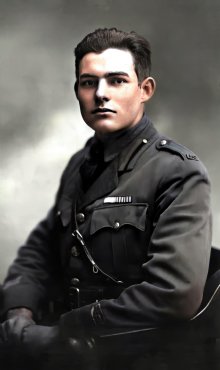Overview
Ernest Hemingway’s A Farewell to Arms follows Frederic Henry, an American serving as a lieutenant in the Italian ambulance corps during World War I, whose love affair with the English nurse Catherine Barkley becomes a temporary sanctuary from the chaos of war. Told in spare, understated prose, the novel moves from tentative flirtation to profound attachment, then from battlefield disillusionment to a brief idyll of exile, ending in an uncompromising confrontation with loss. The book fuses a war narrative with an intimate love story, using imagery of rain, rivers, and mountains to trace the characters’ search for shelter from violence, fate, and the indifferent natural world.
Plot
Henry is stationed near the Isonzo front, where he meets Catherine, who is grieving a fiancé lost in the British army. Their initial games of affection gradually deepen into love. Henry is wounded by mortar fire at the front and sent to a hospital in Milan, where Catherine nurses him. Away from the lines, their intimacy flourishes, and he looks forward to a convalescent leave with her. Bureaucratic friction and his own indulgences shorten his respite, and he returns to the front as the Austro-German offensive begins to break the Italian defenses.
During the catastrophic retreat from Caporetto, Henry and his ambulance drivers try to shepherd wounded men through rain, mud, and panic. They become entangled in chaos and arbitrary authority as military police begin executing officers for supposed desertion. A comrade is shot by friendly troops, another drifts away, and despair spreads through the columns. Facing summary judgment himself, Henry escapes by throwing himself into a river, an act he later calls his farewell to the war. He resolves to find Catherine and abandon the conflict.
In Stresa he reunites with Catherine, now pregnant, and with the help of friends they flee by rowing across Lake Maggiore to neutral Switzerland. In the winter calm of a mountain village, they live modestly and tenderly, imagining a future free of uniforms and orders. In the spring they move to Lausanne for the birth. The long labor ends in a stillborn child. Catherine hemorrhages and dies despite the doctors’ efforts. Henry stays with her body, then leaves the hospital and walks back alone in the rain.
Characters and motifs
Henry narrates with a wary, unsentimental intelligence, learning to distrust rhetoric and abstractions. Catherine, witty and self-aware, commits herself to love with a mix of playfulness and fatalism born of earlier loss. Rinaldi, Henry’s friend and surgeon, embodies bravado and exhaustion; the gentle priest offers a counterpoint of faith and longing for the peace of the Abruzzi. Rain recurs as a forewarning of danger and death, while rivers mark moments of passage and attempted cleansing. The mountains promise safety and clarity, in contrast to the plains where orders and mud swallow men.
Themes and style
The novel confronts the randomness of violence and the emptiness of patriotic language when measured against individual suffering. Love becomes a provisional refuge, not a guarantee, and courage is recast as endurance and truthfulness rather than spectacle. Hemingway’s restrained sentences and exact physical detail create emotional force through omission and understatement, leaving meanings to accumulate beneath the surface. The ending refuses consolations, aligning private grief with the larger, impersonal weather of history, and leaving Henry’s farewell as both an escape from war and an acceptance of the limits of human control.
A Farewell to Arms
This novel, set during World War I, follows an American ambulance driver on the Italian front and his love affair with a British nurse.
Author: Ernest Hemingway
 Ernest Hemingway, his literary contributions, and the profound impact of his adventurous lifestyle on his celebrated works.
Ernest Hemingway, his literary contributions, and the profound impact of his adventurous lifestyle on his celebrated works.
More about Ernest Hemingway
 Ernest Hemingway, his literary contributions, and the profound impact of his adventurous lifestyle on his celebrated works.
Ernest Hemingway, his literary contributions, and the profound impact of his adventurous lifestyle on his celebrated works.